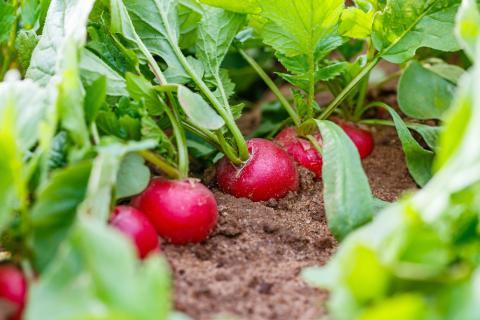
As the weather cools down it's a great time to start thinking ahead for the darker days to come. That should also reflect in your garden! Here are 5 vegetables to start growing in early fall so you have a bountiful harvest throughout the rest of the season!
Garlic
Thinking about growing garlic? Then it’s definitely best to start now! Garlic prefers cool weather when developing its foliage and warm weather when bulbs enlarge. Fall plantings usually take about 8 months to mature. It’s a good idea to plant garlic in early fall.
You shouldn’t use cloves from the supermarket—they may carry disease and are usually treated to discourage sprouting. They also might not be the right varieties to grow in your climate. You’re better off getting bulbs from a garden center, mail order suppliers, or a local source like a farmers market.
Make sure to break the bulbs apart, keeping papery husks on the individual cloves. Then, plant with the tips up, about 2 inches deep and 2 to 6 inches apart in rows 15 to 24 inches apart. It’s a good idea to mulch heavily after planting.
You might be able to harvest some garlic greens throughout fall, which are edible.
Turnips
Turnips need at least 100 days or more to mature, but they grow their largest, and with the best flavor, when allowed to mature in the fall. Turnips are a very hardy crop, so they won’t be negatively affected when hit by frosts—in fact, they may even taste sweeter after it. Within just one month you can enjoy their bright greens. Early fall is the perfect time to sow them so you get a nice late autumn harvest. Just make sure to select a site that gets plenty of sun with well-draining soil. It might be a good idea to add some compost to the soil and mix it in.
Remember that turnips should be seeded directly into the garden, since they don’t transplant well. You can scatter them—just make sure they’re not covered by more than half an inch of soil.
Once the seedlings pop up and are about 4 inches high, you can thin them to 4 to 6 inches apart. The rows should be about 12 inches apart. For turnips grown for greens, thin them 2 to 3 inches apart (or don’t even bother thinning if you’re just after the greens—up to you). Afterwards, be sure to mulch to suppress weeds and retain moisture.
Radishes
Radishes grow very similar to turnips. They don’t need very much care and they’re very hardy. The other great thing about them is they grow relatively quickly and in cool, moist soil. If you hate the woody texture, the hot and bitter taste of spring radishes, you’ll find those problems dissipate with sowing them in the fall.
Make sure to plant them in a sunny spot with soil rich in organic matter (but not compacted). If you have soil that’s more clay-like, mix in some sand to help improve drainage and loosen it up. You can also add compost to help soil that isn’t rich in organic matter. Make sure to till the garden bed to remove dirt clods or rocks before planting too.
Plant the radishes directly into the soil, as they don’t take kindly to being transplanted (similar to turnips, ‘ey?). You should sow seeds half an inch to 1 inch deep and 1 inch apart in rows 12 inches apart. Consider putting a thin layer of mulch around the radishes to ensure moisture is retained in the soil.
Beets
Beets, like any root vegetable, should definitely be grown from seed and directly in the ground. You don’t want to disturb the root once it’s growing, after all. Beets can grow in the summer, but they tend to taste a bit woody and get bitter quickly. That’s why it’s best to sow them in early fall—the bulbs will grow even throughout the cold, and the tops can handle a bit of frost too. They only take about 6 to 8 weeks to grow too, which means they’re a relatively quickly growing crop.
Interestingly enough, each beet seed is actually a hard little cluster of 2 or 4 seeds. It’ll take a few days to a week for the seeds inside to germinate. When they do, you’ll have to thin out (and eat) the extra seedlings. All parts of the beets are edible, after all.
Beets prefer full sun, so make sure to keep that in mind while planting. Sow seeds half an inch deep and 1 to 2 inches apart in rows that are about 12 inches apart. Make sure to cover the seeds with soil and tap with your hand or a rake gently. You might like to add some mulch to help the soil retain its moisture.
Broccoli
Broccoli actually grows really well in cool weather, so planting it in fall just makes sense. It does take a while to mature, so be prepared to have a late fall harvest, or possibly even an early winter harvest. The good news about planting it in early fall is that the weather is still fairly warm, so the little seedlings won’t die from sudden frosts.
Broccoli requires full sun and moist soil that’s fertile and slightly acidic. Definitely work in some compost to your soil before planting anything. Plant the seeds half an inch deep, making sure to space your plants 12 to 24 inches apart with 36 inches between each row. Make sure to suffocate any weeds with mulch.
Want to know more veggies you should be planting this season? Here are 8 plants to grow in your autumn garden.








